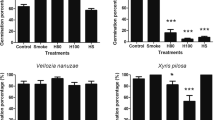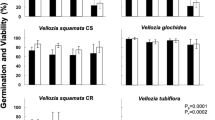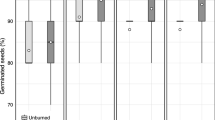Abstract
The endemic flora of the Canary Islands is remarkable but highly vulnerable to environmental changes. Several factors, such as fire, could be threatening. The purpose of this study was to analyze various treatments in endemic threatened species which could have been growing in the understory of the Canary pine forest. We attempted to improve germination through dormancy breaking, and analyze the influence of fire on these plants. Seven physical and chemical treatments were tested: control, mechanical scarification, boiling water, dry heat (50 and 120 °C), smoke and smoked water. Mechanical scarification showed a positive response in germination percentage in two species characterized by hard seed coat, but out of all of the species tested, only one demonstrated a positive response to any of the treatments related to fire. At the temperatures registered on wildfires, neither the seeds situated on the aerial structure nor seeds in seed bank seem to be able to survive and germinate. The increasing incidence of fires through anthropogenic causes could contribute to the current threat status of these species and poorness of the Canary pine forest understory.


Similar content being viewed by others
References
Acebes JR, León MC, Rodríguez ML, Del Arco MJ et al (2010) Pteridophyta, spermatophyta. In: Arechavaleta M, Rodríguez S, Zurita N, García A (eds) Lista de especies silvestres de Canarias. Hongos plantas y animales terrestres. Gobierno de Canarias, Santa Cruz de Tenerife, pp 119–172
Addinsoft (2012) XLSTAT 2012.07.03. http://www.xlstat.com
Arévalo JR, Fernández-Palacios JM, Jiménez MJ, Gil P (2001) The effect of fire intensity on the understory species composition of two Pinus canariensis reforested stands in Tenerife (Canary Islands). For Ecol Manag 148:21–29
Arnan X, Rodrigo A, Retana J (2006) Post-fire recovery of Mediterranean ground ant communities follows vegetation and dryness gradients. J Biogeogr 33:1246–1258
Bañares A, Blanca G, Güemes-Heras J, Moreno-Saiz JC, Ortíz-Núñez S (2003) Atlas y Libro Rojo de la Flora Vascular Amenazada de España. Dirección General de Conservación de la Naturaleza, Madrid
Bradshaw SD, Kingsley WD, Hopper SD, Lambers H, Turner SR (2011) Little evidence for fire-adapted plant traits in Mediterranean climate regions. Trends Plant Sci 16(2):69–76
Bradstock RA, Auld TD (1995) Soil temperatures during experimental bushfires in relation to fire intensity: consequences for legume germination and fire management in Southeastern Australia. J Appl Ecol 92:76–84
Bramwell D (1990) Conserving biodiversity in the Canary Islands. Ann Mo Bot Gard 77:28–37
Bramwell D, Bramwell Z (2001) Flores Silvestres de las Islas Canarias, 4th edn. Editorial Rueda, Madrid
Buhk C, Hensen I (2006) “Fire seeders” during early post-fire succession and their quantitative importance in South-Eastern Spain. J Arid Environ 66:193–209
Buhk C, Meyn A, Jentsch A (2007) The challenge of plant regeneration after fire in the Mediterranean basin: scientific gaps in our knowledge on plant strategies and evolution of traits. Plant Ecol 192:1–19
Climent J, Tapias R, Pardos JA, Gil L (2004) Fire adaptations in the Canary Islands pine (Pinus canariensis). Plant Ecol 171:185–196
Cowling R, Rundel PW, Lamont BB, Arroyo MK, Arianoutsou M (1996) Plant diversity in mediterranean-climate regions. Trends Ecol Evol 11(9):362–366
De Lange JH, Boucher C (1990) Autoecological studies on Audonia capitata (Bruniaceae). I. Plant-derived smoke as a seed germination cue. S Afr J Bot 56:188–202
DeBano LF (2000) The role of fire and soil heating on water repellency in wildland environments: a review. J Hydrol 231–232:195–206
DeBano LF, Dunn PH, Conrad CE (1977) Fire’s effect on physical and chemical properties of chaparral soils. In: Mooney HH, Conrad CE (eds) Symposium on environmental consequences of fire and fuel management in Mediterranean ecosystems. U.S.D.A. Forest Service General Technical Report WO3, Washington, DC, pp 65–74
Del Arco MJ, Wildpret W, Pérez-de-Paz PL, Rodríguez-Delgado O, Acebes JR, García-Gallo A, Martín VE, Reyes-Betancort JA, Salas M, Bermejo JA, González R, Cabrera MV, García S (2006) Mapa de Vegetación de Canarias. GRAFCAN, Santa Cruz de Tenerife
Del Arco MJ, González R, Garzón-Machado V, Pizarro B (2010) Actual and potential natural vegetation on the Canary Islands and its conservation status. Biodivers Conserv 19:3089–3140
Garzón-Machado V, González-Mancebo JM, Palomares-Martínez A, Acevedo-Rodríguez A, Fernández-Palacios JM, Del-Arco-Aguilar M, Pérez-de-Paz PL (2010) Strong negative effect of alien herbivores on endemic legumes of the Canary pine forest. Biol Conserv 143:2685–2694
Garzón-Machado V, Del-Arco-Aguilar M, Pérez-de-Paz PL (2011) A tool set for description and mapping vegetation on protected natural areas: an example from the Canary Islands. Biodivers Conserv 20:3605–3625
Gilmour CA, Crowden RK, Koutoulis A (2000) Heat shock, smoke and darkness: partner cues in promoting seed germination in Epacris tasmanica (Epacridaceae). Aust J Bot 48:603–609
Gómez-Campo C et al (1996) Libro Rojo de Especies Amenazadas de las Islas Canarias. Gobierno de Canarias, Santa Cruz de Tenerife
Gómez-González S, Sierra-Almeida A, Cavieres LA (2008) Does plant-derived smoke affect seed germination in dominant woody species of the Mediterranean matorral of central Chile? For Ecol Manag 255:1510–1515
González-Martín M (1998) Germinacion de especies endémicas canarias del género Convolvulus L. en Gran Canaria (Islas Canarias). Invest Agric Prod Prot Veg 13(3):307–318
Herranz JM, Ferrandis P, Martínez-Sánchez JJ (1998) Influence of heat on seed germination of seven Mediterranean Leguminosae species. Plant Ecol 136:95–103
ISTAC (2012) Viceconsejería de Medio Ambiente 2012.07.03. http://www.gobiernodecanarias.org/istac
Jayasuriya KMGG, Baskin JM, Baskin CC (2008) Dormancy, germination requirements and storage behavior of seeds of Convolvulaceae (Solanales) and evolutionary considerations. Seed Sci Res 18:223–237
Keeley JE, Fotheringham CJ (2000) Role of fire in regeneration from seed. In: Fenner M (ed) Seeds: the ecology of regeneration in plant communities, 2nd edn. CAB International, Wallingford
Keeley JE, Keeley M, Fotheringham CJ (2005) Alien plant dynamics following fire in Mediterranean-climate California shrublands. Ecol Appl 15:2109–2125
Klaus W (1989) Mediterranean pines and their history. Plant Syst Evol 162:133–163
Luna B, Moreno JM, Cruz A, Fernández-González F (2007) Heat-shock and seed germination of a group of Mediterranean plant species growing in a burned area: an approach based on plant functional types. Environ Exp Bot 60:324–333
Malkisnon D, Wittenberg L, Beeri O, Barzilai R (2011) Effects of repeated fires on the structure, composition, and dynamics of Mediterranean maquis: short- and long-term perspectives. Ecosystems 14:478–488
Médail F, Quézel P (1997) Hot-spots analysis for conservation of plant biodiversity in the Mediterranean basin. Ann Mo Bot Gard 84:112–127
Millar CI (1993) Impact of the eocene on the evolution of Pinus L. Ann Mo Bot Gard 80:471–498
Moreira B, Tormo J, Estrelles E, Pausas JG (2010) Disentangling the role of heat and smoke as germination cues in Mediterranean basin flora. Ann Bot 105:627–635
Moreno JC (2008) Lista Roja 2008 de la flora vascular española. Dirección General de Medio Natural y Política Forestal, Madrid
Myers N, Mittermeier RA, Mittermeier CG, Da Fonseca GAB, Kent J (2000) Biodiversity hotspots for conservation priorities. Nature 403:853–858
Otto R, García-del-Rey E, Gil-Muñoz P, Fernández-Palacios JM (2010) The effect of fire severity on first-year seedling establishment in a Pinus canariensis forest on Tenerife, Canary Islands. Eur J For Res 129:499–508
Parker VT, Kelly VR (1989) Seed bank in California chaparral and other Mediterranean climate shrublands. In: Leck MA, Parker VT, Simpson RL (eds) Ecology of soil seed bank. Academic Press, San Diego, pp 231–256
Pausas JG, Llovet J, Rodrigo A, Vallejo R (2008) Are wildfires a disaster in the Mediterranean basin?—A review. Int J Wildland Fire 17:713–723
Pérez-de-Paz PL, Del Arco MJ, Rodríguez-Delgado O, Acebes JR, Marrero M, Wildpret W (1994) Atlas cartográfico de los pinares canarios III, La Palma. Viceconsejería de Medio Ambiente. Consejería de Política Territorial, Gobierno de Canarias, Santa Cruz de Tenerife
Pérez-García F, González-Benito ME (2006) Seed germination of five Helianthemum species: effect of temperature and presowing treatments. J Arid Environ 65:688–693
Pérez-García F, González-Benito ME, Gómez-Campo C (2008) Germination of fourteen endemic species from the Iberian Peninsula, Canary and Balearic Islands after 32–34 years of storage at low temperature and very low water content. Seed Sci Technol 36:407–422
Piñol J, Terradas J, Lloret F (1998) Climate warming, wildfire hazard, and wildfire occurrence in coastal eastern Spain. Clim Change 38:345–357
Reyes O, Trabaud L (2009) Germination behaviour of 14 Mediterranean species in relation to fire factors: smoke and heat. Plant Ecol 202:113–121
Rivas M, Reyes O, Casal M (2006) Influence of heat and smoke treatments on the germination of six leguminous shrubby species. Int J Wildland Fire 15:73–80
Robles AB, Castro J (2002) Effect of thermal shock and ruminal incubation on seed germination in Helianthemum apenninum (L.) Mill. (Cistaceae). Acta Bot Malacitana 27:41–47
Santos A (1983) Vegetación y Flora de La Palma. Editorial Interinsular Canaria, S.A. Santa Cruz de Tenerife
Santos A (1993) Helianthemum cirae spec. nova (Cistaceae—Sect. Helianthemum) in the flora of La Palma, Canary Islands. I Symposio de Flora y Fauna de las Islas Atlánticas, Madeira
Simpson RL, Leck MA, Parker VT (1989) Seed banks: general concepts and methodological issues. In: Leck MA, Thomas VT, Simpson RL (eds) Ecology of soil seed banks. Academic Press, San Diego, pp 3–8
Syphard AD, Radeloff VC, Hawbaker TJ, Stewart I (2009) Conservation threats due to human-caused increases in fire frequency in Mediterranean-climate ecosystems. Conserv Biol 23(3):758–769
Thanos CA, Doussi MA (1995) Ecophysiology of seed germination in endemic labiates of crete. Israel J Plant Sci 43:227–237
Tompsett PB, Pritchard HW (1998) The effect of chilling and moisture stress on the germination, desiccation tolerance and longevity of Aesculus hippocastanum L. seeds. Ann Bot 82:249–261
Trabaud L (1979) Etude du comportement du feu dans la garrigue de Chêne Kermès è partir des témperatures et des vitesses de propagation. Ann For Sci 36:13–18
Trabaud L (1997) Are wildland fires threatening the Mediterranean flora and vegetation? Ecosyst Sustain Dev 1:137–146
Acknowledgments
The authors would like to thank Alexandra Rodríguez and Raquel Hernández for their help with the daily seed count, and Antonio Rodríguez-Lerín for his hard work in collecting seeds. The authors would also like to thank Ángel Palomares-Martínez, Aurelio Acevedo-Rodríguez, Mercedes Díaz and the maintenance team of Caldera de Taburiente National Park for their invaluable help. The authors would also like to acknowledge the critical revision and opinions of J. C. Luis-Jorge and Juana Mª González-Mancebo, who helped to improve the manuscript.
Author information
Authors and Affiliations
Corresponding author
Rights and permissions
About this article
Cite this article
Garzón-Machado, V., del Arco Aguilar, M.J., González, F.V. et al. Fire as a threatening factor for endemic plants of the Canary Islands. Biodivers Conserv 21, 2621–2632 (2012). https://doi.org/10.1007/s10531-012-0321-3
Received:
Accepted:
Published:
Issue Date:
DOI: https://doi.org/10.1007/s10531-012-0321-3




